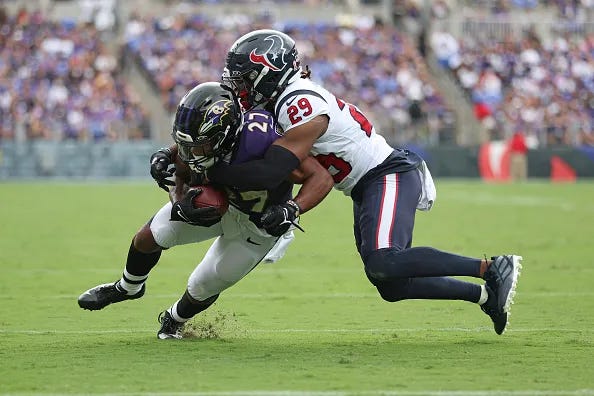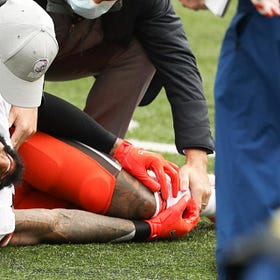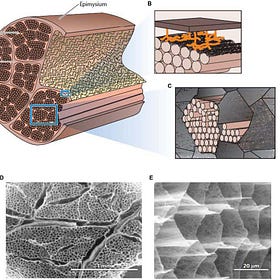Aaron Rodgers Achilles Tendon Rupture: A Black Swan?
Aaron Rodgers injury is not a Black Swan to subscribers of Absolute.

What is a Black Swan?
Essayist Nassim Taleb popularized the concept of a black swan in his book titled The Black Swan: The Impact of the Highly Improbable and defined it as:
An event with the following three attributes. First, it is an outlier, as it lies outside the realm of regular expectations, because nothing in the past can convincingly point to its possibility. Second, it carries an extreme impact…. Third, in spite of its outlier status, human nature makes us concoct explanations for its occurrence after the fact, making it explainable and predictable.
Aaron Rodgers's Achilles tendon injury was a black swan, right?… Wrong.
To Aaron Rodgers, the media, the entire Jets organization, and NFL fans everywhere, Rodgers' torn Achilles more than likely represents a black swan event. This perception arises from the fact that, to these individuals and groups, the injury occurred outside of their expectations, a highly improbable event leading them to classify it therefore as highly unlikely. This reasoning stems from their belief that Rodgers' injury could not have been foreseen, precisely because they did not foresee it. In understanding Taleb's criteria for a black swan event, it becomes evident to both our subscribers and us at Absolute that Aaron Rodgers' injury does not fit within the characterization as described by Taleb; it's more aptly categorized as a ‘white swan.
This distinction becomes especially clear when we consider the current NFL season, which has already had fourteen Achilles tendon ruptures (and 19 ACL ruptures), and we are only at week one. To illustrate this point further, just a day before Rodgers' injury, Ravens running back J.K. Dobbins suffered a complete Achilles tendon tear. The fact that, this same injury has already occurred thirteen times among NFL athletes this early at the level of competition, categorizes it as a 'white swan,' not a 'black swan.' Even though Rodgers’ injury carries an extreme impact both to him and the Jets organization, it is by no means an outlier. Due to the complete blindspot of training connective tissue in modern sports, these white swans sadly show up with regular consistency in the NFL. So far in the 2023/24 season, a torn Achilles has become an unfortunate and anticipated occurrence.
Aaron Rodgers's injury is a “white swan” to both our subscribers and us at Absolute.

Tissue Senescence - A Potential Biological Risk Factor in Rodgers’ Injury
It is hard to argue the role that a 290 lb lineman played in the case of Aaron Rodgers’ achilles rupture. Having a large human wrapped around his legs with the intent to drag him to the ground obviously places him in a somewhat vulnerable position. With that said, however, at the quarterback position, this type of play happens multiple times in a game, and over the course of a season, a quarterback would have to scramble in this type of situation hundreds of times. Considering this fact, then, why did Rodgers achilles fail him on this play, this early in the game, at this point in his career?
All interesting questions to consider as the injury cannot simply be chalked up to the details of the play - Rodgers getting trapped in a position with a defender and the achilles buckling under that load. This shows an external bias to the injury as most would take, which is why many experts to this point have stated that the injury had little to do with Rodgers’ internal tissue capacity and was simply a consequence of the game. In saying so, downplaying the role of a previous calf injury, as well as the accumulation of tissue stress over the course of his career that definitely impacts the type of strength that composites of tissue are designed to display at times when that behaviour is required. It must be borne in mind that with any injury, it is contextual (performance specific), but regardless of the context, it is ALWAYS tissue specific. There is always a biological impact of an injury affecting one or more of the elements of anatomy. This will impair tissue output over time unless specifically addressed.
Chronologically, Aaron Rodgers is 39 years old, which puts him close to a decade older compared to the average age of an NFL quarterback. Biologically he is much older, and in the case of his injury, biological age must be considered a factor within the web of determinants. Chronological aging and biological aging are different. The state or process of aging, especially in humans, describes chronological aging, which is an obvious movement of time from birth to death. Biological aging is far different and is not correlated to chronological age. It refers to the age of the parts that make up the ecology of the internal system and is related to the purposeful intent to maintain those parts over the chronological movement of time. Biological age refers to the quality of specific tissue maintenance and repair and how that can allow a slowing of the chronological arrow of time.
There is much evidence to show that as we age, our tissues change. Particularly in white connective tissue, elasticity decreases while generalized stiffness increases as a result of a decrease of cellular turnover, regeneration mechanisms, and a change of biochemical markers. This is tissue senescence - the gradual decline of biological homeostatic mechanisms that allow for the maintenance of a strict internal ecosystem that ultimately causes a progressive decline in those mechanisms.
The key feature of tissue senescence and its relationship to Aaron Rodgers is the evolutionary trade-off that occurs between youthful vigor and aging that occurs biologically. In a manner that allows for the maximization of organismal fitness, natural selection always favours vigour over longevity. This has three important characteristics that relate to this injury:
This will allow for the progressive healing and regeneration of repeated soft tissue insults in early chronological ages (during the prime reproductive years)
This will accelerate biological age in later chronological years
The accumulation of repeated tissue insults skews the selective process towards youthful vigour therefore minimizing the potential for longevity.
It can be argued that with Rodgers being a quarterback with numerous non-specific tissue insults underlying specific tissue insults (see: calf strain), there has been an accumulation of tissue stress that has taxed the homeostatic mechanisms responsible for the progressive adaptation of these tissues. This, on top of the fact that there may have been no tissue-specific training applied, has skewed selection to attempt to maximize his vigour while compromising his tissue longevity, ultimately making his biological age much greater than his chronological age.
Lack of Reactive Strength: Aaron Rodgers, Cooper Kupp, and Joe Burrow
At Absolute, we continually emphasize the importance of achieving Point B, where an athlete is in an optimal physical state for competition. One fundamental aspect of this state is reactive strength, and it's worth noting that Aaron Rodgers' history includes a deficiency in this capacity, such as his recent 'minor calf strain' in OTA’s prior to this tissue exploding on Monday night. This very issue, a lack of reactive strength, is what's currently sidelining Cooper Kupp and perplexing the entire Rams organization. It's also affecting the highest-paid player in the NFL, Joe Burrow.
What ties all these athletes together is their shared deficiency in reactive strength, leading to their removal at the level of competition or, in Burrow's case, significant challenges at the level of competition. All of these situations underscore the likelihood of mismanagement, both on the part of the athletes themselves and those responsible for their physical capacity.
It Must be the Artifical Turf…

While injuries in sports are complex and multifaceted, Bakhtiari's explanation falls short in accounting for Dobbin's injury, which occurred just a day prior on natural grass. The current state of the NFL's injury woes involves multiple factors, and while turf may play a part, the NFLPA's strategy to enhance player safety has already, in week one, proven a complete failure. We had identified this strategy as complete trash back in June, not only predicting its inevitable failure but also advocating that players should prepare their connective tissues to perform on both natural grass and artificial surfaces.
In a desperate attempt to prevent what we saw as inevitable, we even provided an Achilles tendon training template for players. While the situation is unfortunate for all parties involved, players merely complaining about team owners does not contribute to enhancing player safety. The real solution lies in something we've been emphasizing for years: training reactive strength.
The Ongoing Debate: Natural Grass vs. Artificial Surfaces in the NFL + Training Template to Improve Player Safety
Natural Grass vs. Artificial Surfaces There is an interesting ongoing debate between the NFL Players Association (NFLPA), the union representing NFL players, and the NFL regarding playing surfaces and player safety. The debate is: what type of playing surface is safer for the players - natural grass or artificial surfaces?
Suboptimal Reactive Strength Training: The Driving Factor
The driving factor for all these connective tissue explosions is a lack of capacity. This means: that training is the leverage point in eliciting a shift in the football ecosystem of enhancing player safety in regard to connective tissue injuries.
Establishing Point B: Reactive Strength
To continue in our series on Establishing Point B, which focuses on the four fundamental physical capacities any athlete should possess to achieve an optimal level of high performance is the quality known as Reactive Strength. Reactive strength is not a new term, but definitely might not be in the lexicon of many coaches due to a misunderstanding of what…







I've been bringing this conversation (recent pro athlete injuries) into the treatment space/time with many patients. The way we review the injuries here in this group is easily shared with the lay person I feel. Certainly the tissue specific nature of our conversation should make sense to an FRS practitioner, interestingly it also makes perfect sense to the lay person when simply explained.